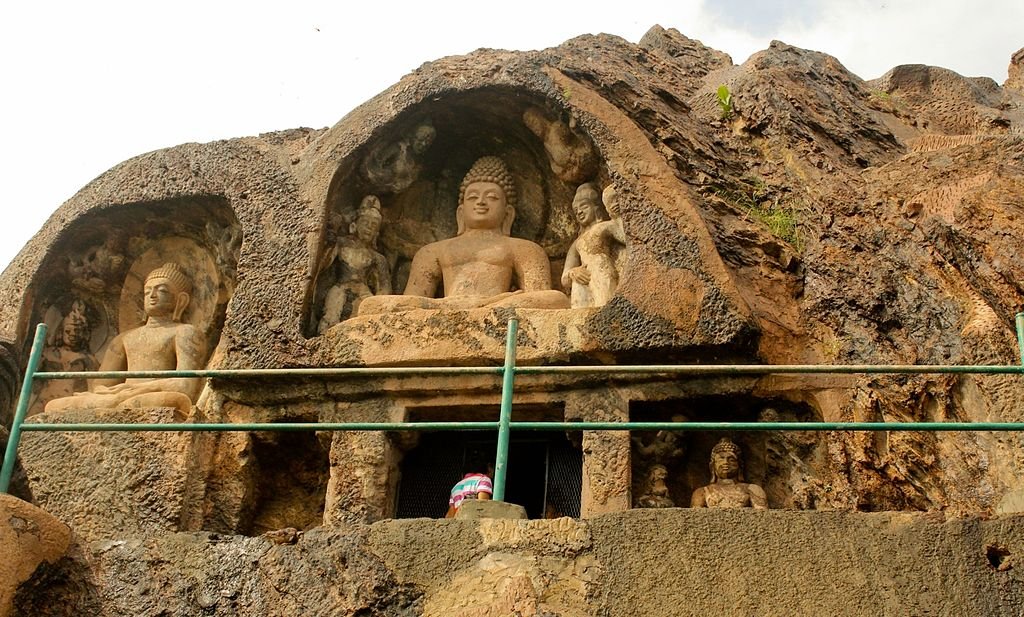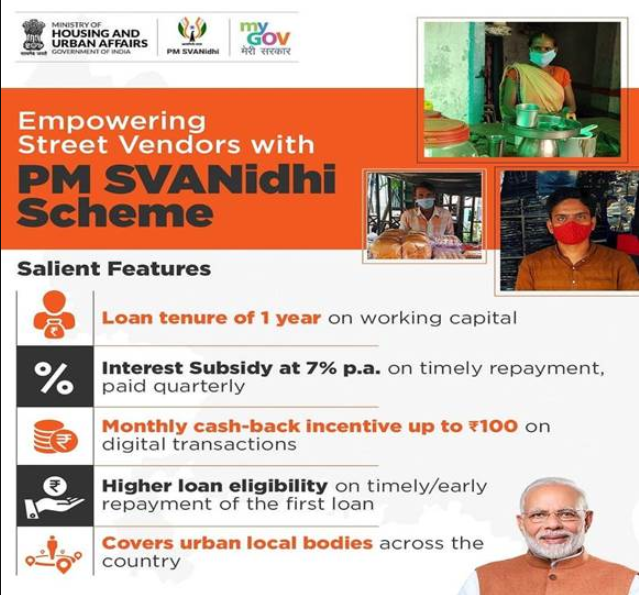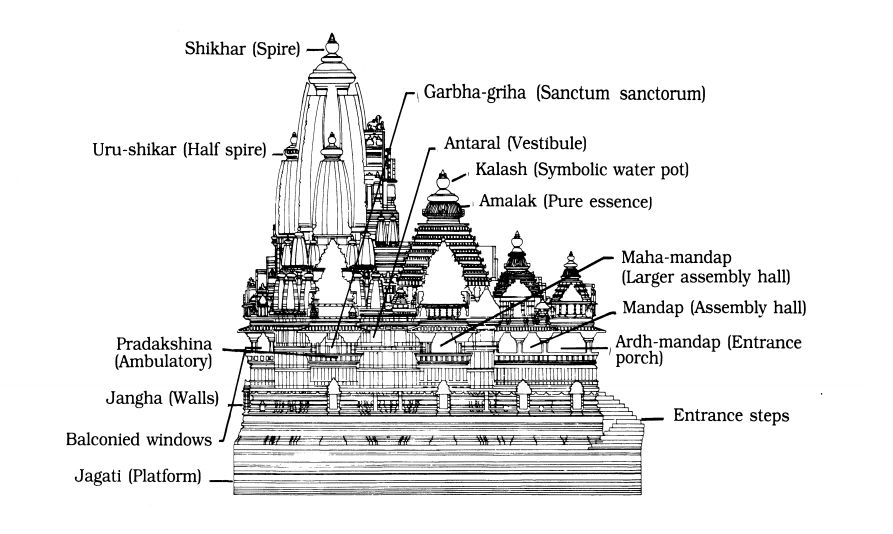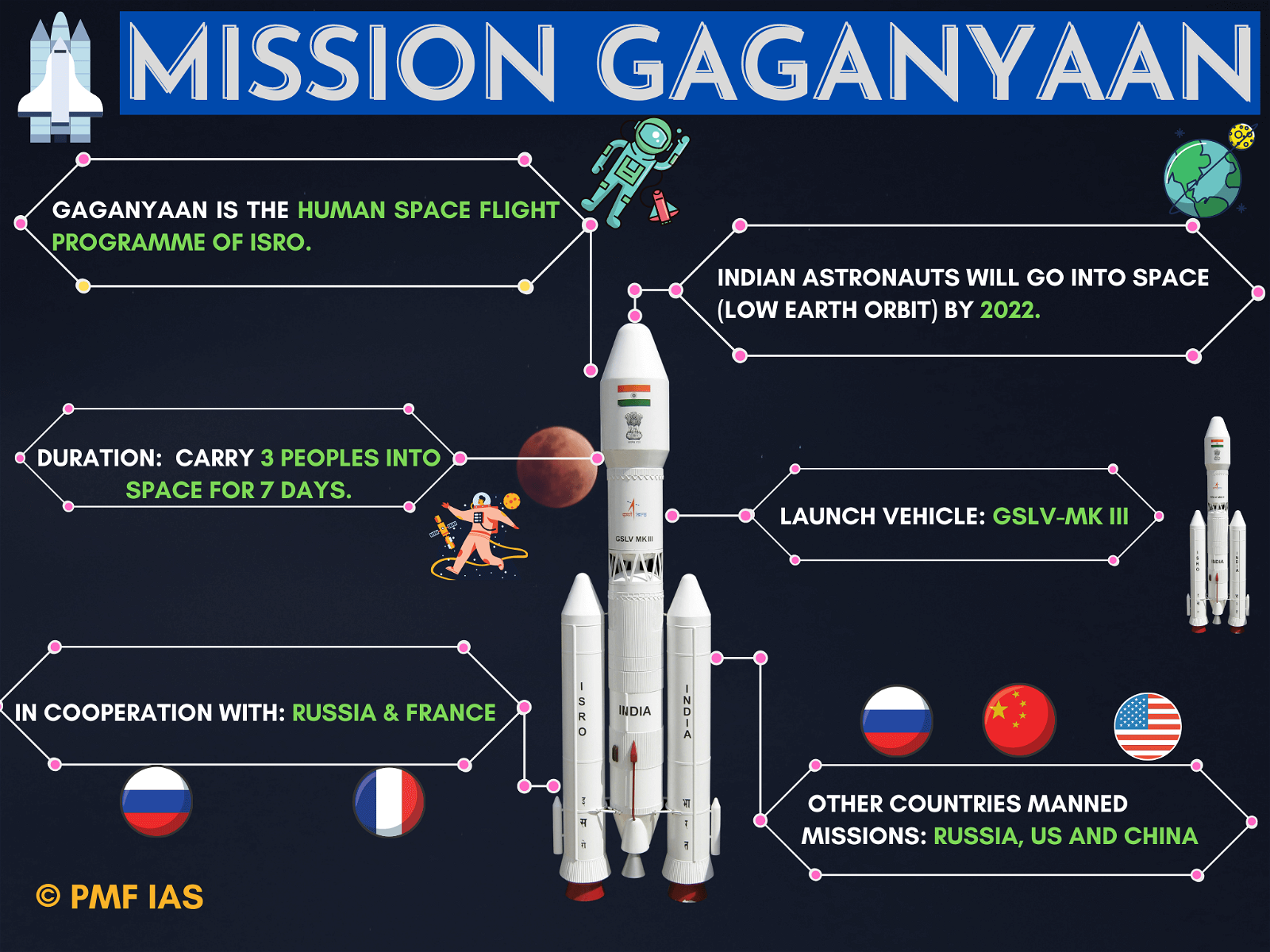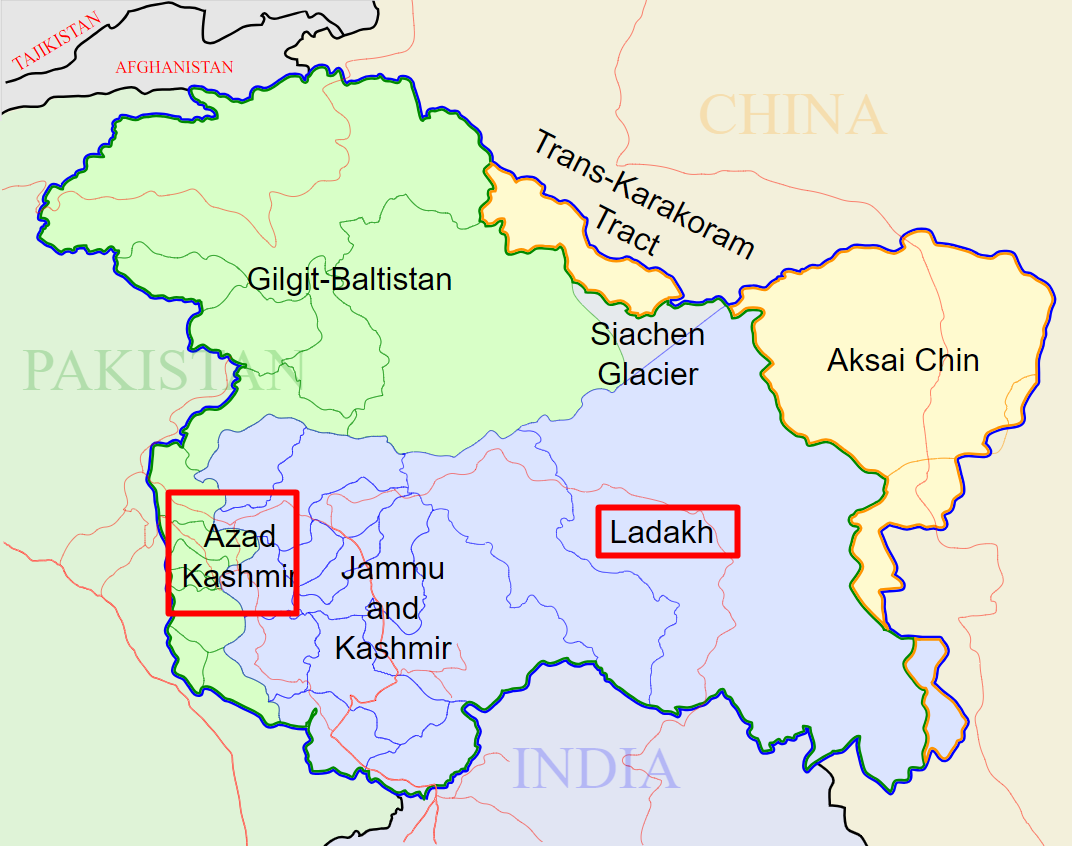
Current Affairs July 28, 2023: The Cinematograph (Amendment) Bill, 2023, CBI and ED, Circular Economy Coalition, The Jan Vishwas (Amendment of Provisions) Bill, 2023, AI, INDIAai
Subscribers of "Current Affairs" course can Download Daily Current Affairs in PDF/DOC
Subscribe to Never Miss an Important Update! Assured Discounts on New Products!
Must Join PMF IAS Telegram Channel & PMF IAS History Telegram Channel
{GS2 – MoIB – 2023/07/28} The Cinematograph (Amendment) Bill, 2023
- Context (PRS): The Rajya Sabha passed the Cinematograph (Amendment) Bill, 2023.
The Cinematograph Act of 1952
- The Act was enacted to regulate the use and exhibition of cinematographs (film projectors) and the content shown in films across India.
- Certification: The Act empowers the Central Board of Film Certification (CBFC) to review and certify films before their public exhibition.
- The CBFC ensures that films comply with certain guidelines and categories, such as:
- “U” (Universal/Without restrictions),
- “UA” (Without restrictions but under parental guidance),
- “A” (Only to adults), and
- “S” (only to members of any profession or class of persons).

- Validity of Certification: The certificate issued by the Board is valid for 10 years.
- Content Censorship: The Act also allows the CBFC to make cuts or modifications to the content of films if it deems certain scenes or elements to be objectionable or against the public interest.
- Offenses and Penalties: The Cinematograph Act outlines offences related to unauthorised film exhibition, alteration of certified films, and other violations.
Revisional powers of the central government
- The Act empowers the central government to examine and make orders to CBFC for films that have been certified or are pending certification.
- In 1991, SC decided that the Government cannot instruct the CBFC to enforce additional cuts in films.
- Since then, the government has been unable to direct CBFC for additional cuts in films beyond what the CBFC has already approved.
Cinematograph (Amendment) Bill, 2023
- The bill introduces new age ratings for films and stringent anti-piracy provisions.
Age ratings
- It introduces three age ratings for films requiring adult supervision (UA) — UA 7+, UA 13+ & UA 16+.
- The IT Rules, 2021, had implemented these graded age ratings for streaming platforms.
Separate certificate for television/other media
- Films with an ‘A’ or ‘S’ certificate will require a separate certificate for exhibition on television or any other media prescribed by the central government.
- CBFC may direct the applicant to carry appropriate deletions/modifications for the separate certificate.
- The Bill provides that the certificates will be perpetually valid.
Revisional power of central government
- The Bill removes the power of the central government to direct the CBFC for additional cuts.
- It formalises power curtailment already in practice after the SC’s order in 1991.
Offenses and Punishments
- The bill prohibits the unauthorised recording of films (section 6AA) and their exhibition (section 6AB).
- These will be punishable with:
- Imprisonment between three months and three years, and
- A fine between three lakh rupees and up to 5% of a film’s production cost.
The Copyright Act, 1957
Central Board of Film Certification (CBFC)
Expert Committee
Recommendations
|
{GS2 – Polity – Bodies – GoI Agencies – 2023/07/28} CBI and ED
- Context (TH): CBI & ED chiefs have fixed tenures of TWO years and a maximum tenure of FIVE years.
- The maximum tenure of five years is possible due to the amendments enacted in 2021 (& upheld by SC in 2023) to the Central Vigilance Commission (CVC) Act and the Delhi Special Police Establishment Act, which allow them a maximum of three annual extensions over the fixed tenure of two years.
Directorate of Enforcement (ED)
- ED is a multi-disciplinary organisation mandated to investigate the offence of money laundering and violations of foreign exchange laws.
- It is under the administrative control of the Department of Revenue, Ministry of Finance, GoI.
History of ED
- ‘Enforcement Unit’ was formed in 1956 in the Department of Economic Affairs to handle violations under the Foreign Exchange Regulation Act, 1947 (FERA ’47).
- In 1957, this Unit was renamed ‘Enforcement Directorate’. In 1960, the administrative control of the Directorate was transferred from the Department of Economic Affairs to the Department of Revenue.
Organisational setup
- The ED, with its headquarters in New Delhi, is headed by the Director of Enforcement. There are regional offices in Mumbai, Chennai, Chandigarh, Kolkata, and Delhi headed by special directors of enforcement.
- It has many Zonal offices headed by a joint directors and sub-zonal offices headed by a deputy director.
Appointment of ED Director
- Under the Central Vigilance Commission Act, 2003 (CVC Act, 2003), the Director of Enforcement is appointed by the central government on the recommendation of a five-member Committee.
- The Central Vigilance Commissioner chairs this Committee and includes Vigilance Commissioners.
- The Secretaries are from the Ministries of Home Affairs, Personnel, and the Revenue Department.
Tenure of the Director
- The Director of Enforcement has a minimum tenure of two years.
- Central Vigilance Commission (Amendment) Act, 2021, adds that the tenure of the Director may be extended by up to one year at a time till the completion of five years from the initial appointment.
- Such extensions may be granted in the public interest on the committee’s recommendation.
Functions of ED
- The statutory functions of the Directorate include the enforcement of the following Acts:
- The Prevention of Money Laundering Act, 2002 (PMLA)
- The Foreign Exchange Management Act, 1999 (FEMA)
- The Fugitive Economic Offenders Act, 2018 (FEOA)
The Prevention of Money Laundering Act, 2002 (PMLA)
- The ED is responsible for enforcing the PMLA by investigating and tracing assets obtained from criminal activities.
- It can temporarily attach properties and ensure that offenders are prosecuted, and their assets are confiscated by the special court.
Contentious Provisions
- PMLA is the only act in the country in which a statement recorded before an investigating officer is admissible in court as evidence. (Other laws that contained such provisions, such as TADA and POTA, have long been repealed)
Stringent bail conditions
- The provision for bail stipulates that a magistrate will not grant bail to an accused unless he is convinced that prima facie no case is made out.
- This has resulted in the accused being put behind bars for long periods without bail in offences that attract punishments ranging from two to seven years, literally making the process the punishment.
The Foreign Exchange Management Act, 1999 (FEMA)
- The ED’s responsibility is to investigate suspected violations of foreign exchange laws and regulations.
- It can also impose penalties on those found to have violated the law after conducting the investigation.
The Fugitive Economic Offenders Act, 2018 (FEOA)
- ED is mandated to attach the properties of the fugitive economic offenders who have fled India to avoid arrest. It can also confiscate their properties and hand them to the Central Government.
The Central Bureau of Investigation (CBI)
- CBI is a non-constitutional, non-statutory body.
- CBI derives power to investigate from the Delhi Special Police Establishment Act, 1946.
- It is the nodal Indian agency that coordinates investigations on behalf of Interpol Member countries.
- It functions under the Department of Personnel, Ministry of Personnel, Pension and Public Grievances, Government of India.
Composition of CBI
- The CBI is headed by a Director. He is assisted by a special director or an additional director and many joint directors, deputy inspector generals (DIG), superintendents of police (SP) and all other ranks of police.
Appointment of CBI Director
- Before the Lokpal Act was legislated, the CBI director was appointed by the DSPE Act.
- Now, the Lokpal Act governs the appointment of the CBI director.
- The Centre appoints the director based on the recommendation of a search committee comprising the
- Prime Minister as the chairperson,
- Chief Justice of India (or supreme court judge) and
- Leader of the Opposition.
Tenure
- Director of CBI has been provided security of two-year tenure by the CVC Act, 2003.
Powers / Functions
- The Central Government can authorise CBI to investigate a crime in a state but only with the consent of the concerned State Government.
- The Central police cannot investigate or enter the state without consent since police and public order are state subjects, and the Centre cannot intervene in law and order matters.
- CBI can suo-moto investigate offences only in the Union Territories (including Delhi).
- The SC and HCs, however, can order CBI to investigate a crime anywhere in the country without the consent of the State.
Types of consent
- There are two kinds of consent:
- Case-specific
- General
- General consent is given to help the CBI seamlessly investigate corruption cases against central government employees in the concerned state. Otherwise, it would require consent in every case.
- States, including West Bengal, Rajasthan, Kerala and Maharashtra, have withdrawn consent to the CBI to freely operate in their respective jurisdictions.
- It means the CBI cannot register any fresh case involving a central government official or a private person stationed in these states without getting case-specific consent.
Case laws
- Vineet Narain’s judgment of 1998 assured the tenure of two years for CBI Director from the day he assumes office. SC held that CBI Director may not be transferred except with the previous consent of the high-level committee.
- In the Union of India versus C. Dinakar (2004) case, the SC had held that “ordinarily IPS officers of the senior most four batches in service on the date of retirement of CBI Director shall be eligible for consideration for appointment to the post of CBI Director”.
- In Prakash Singh’s case(2019), the SC said”No officer with less than six months to retirement should be appointed as police chief”.
Directorate of Enforcement (ED) vs Central Bureau of Investigation (CBI)
| Aspect | ED | CBI |
| Initiation of Case | Can take cognisance of offences across the country without the state government’s consent. | Requires state government’s request or court order to investigate cases |
| Admissibility of a Statement | A statement recorded before an investigating officer is admissible in court as evidence. | A statement recorded before an investigating officer is not admissible as evidence in court. |
| Scope of Investigation | Focused on money laundering and related offences | A broad spectrum of criminal investigations, including corruption, economic offences, and other crimes. |
| Reporting Authority | Reports to the Department of Revenue, Ministry of Finance. | Reports to the Department of Personnel and Training, Ministry of Personnel, Public Grievances, and Pensions. |
{GS3 – Envi – Initiatives – 2023/07/28} Circular Economy Coalition
- Context (TH I PIB): Union Minister of Environment, Forest, and Climate Change launched the Resource Efficiency Circular Economy Industry Coalition (RECEIC).
Circular Economy
- A circular economy is a production and consumption model involving sharing, leasing, reusing, repairing, refurbishing and recycling existing materials and products as long as possible.
- Circular economy is opposite to the traditional linear economy.
Linear Economy vs Circular Economy
- In a linear economy (take, make, waste), natural resources are turned into products destined to become waste because of how they have been designed and manufactured.
- By contrast, a circular economy employs reuse, sharing, repair, refurbishment, remanufacturing and recycling to create a closed-loop system, minimising resource inputs, waste, pollution and emissions.
- The circular economy aims to keep products, materials, equipment and infrastructure in use for longer, thus improving the productivity of these resources.


Advantages of Circular Economy
- Less extraction of virgin raw materials.
- Reduced consumption of fossil fuels.
- Extending the useful life of products through actions such as recycling.
- Decrease in waste generation.
- Innovation and economic growth.
- Allows for a change in consumption habits.
- Greater independence in terms of imports and agility in supply.
- Creation of new jobs.
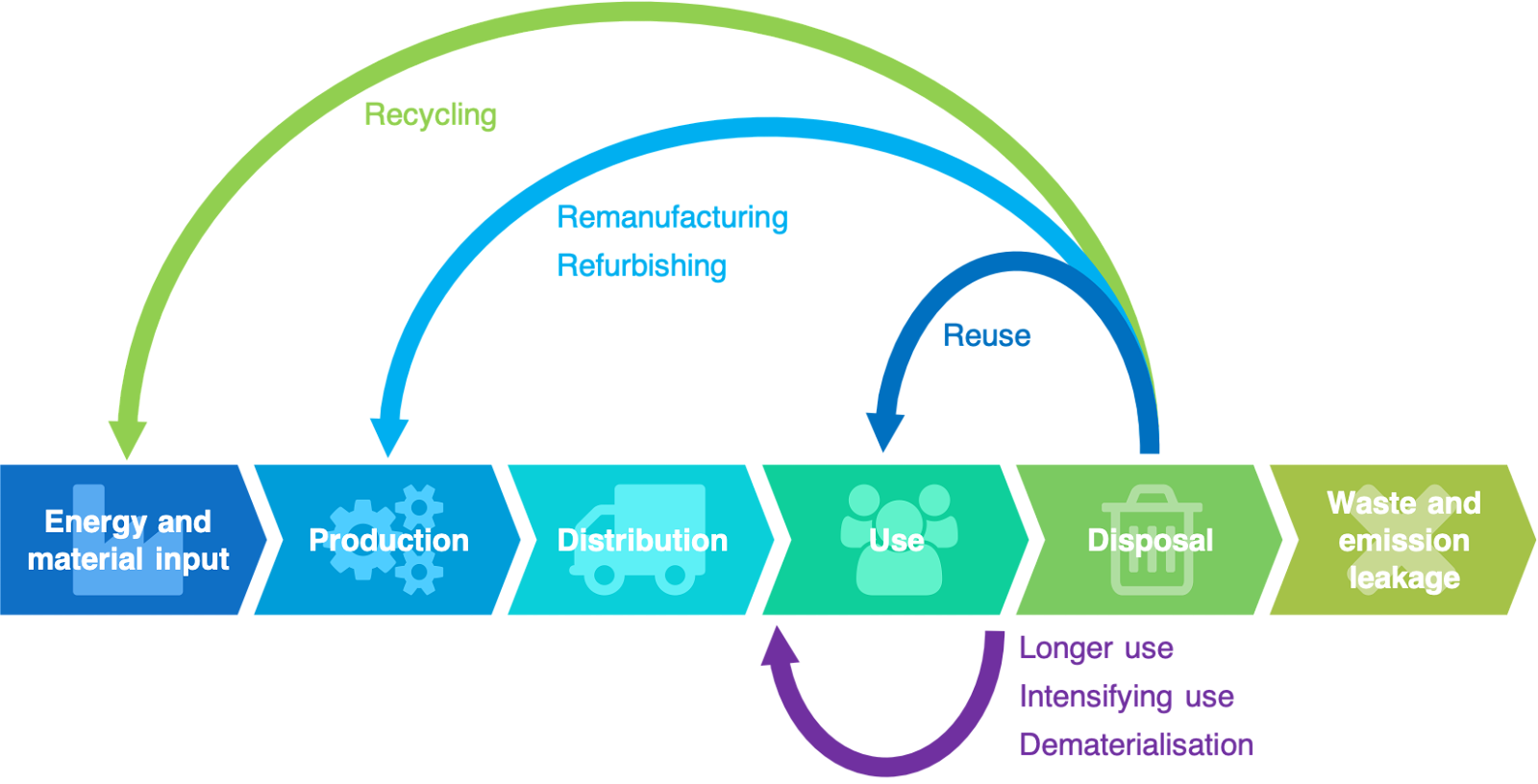
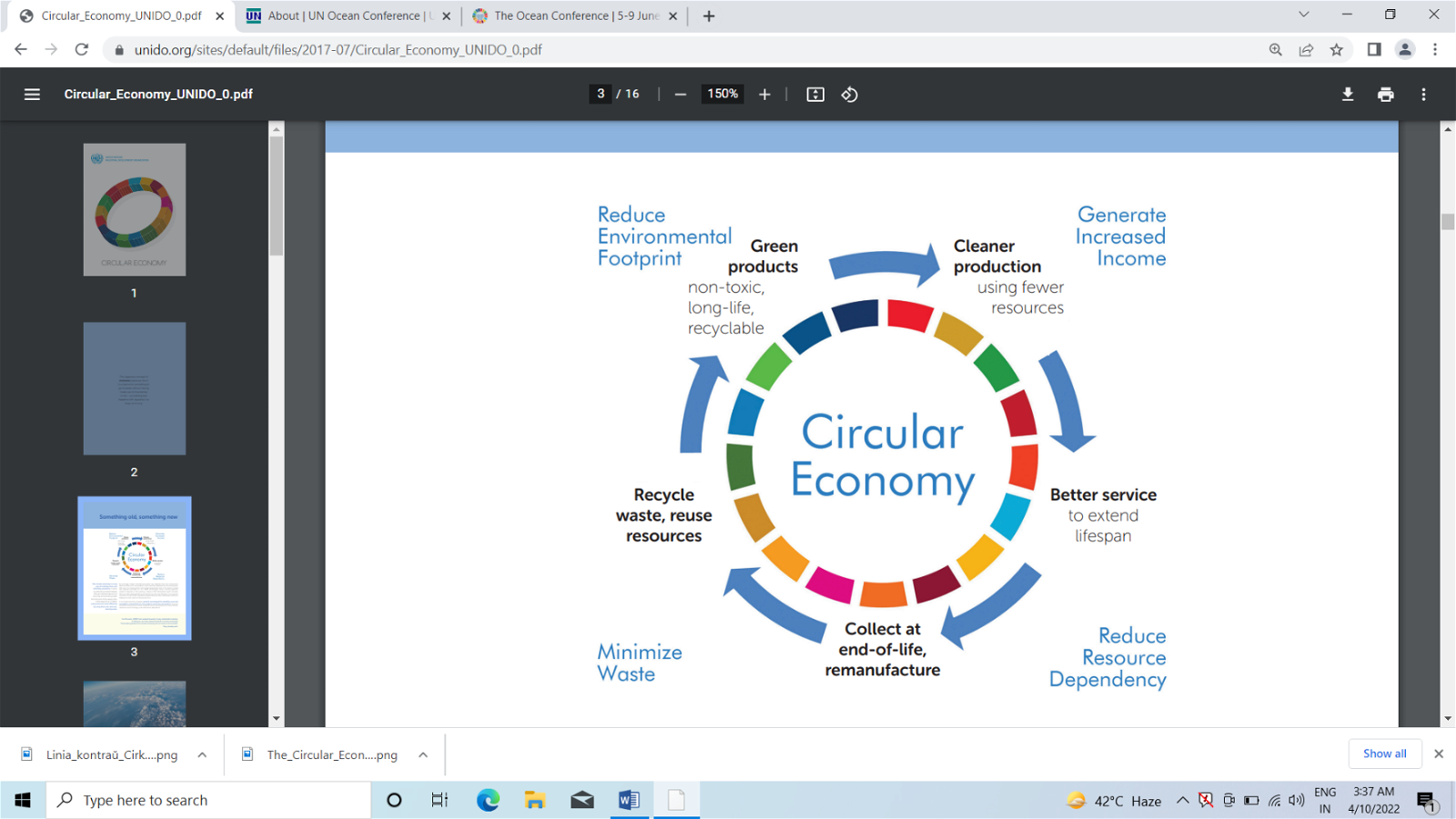
Resource Efficiency Circular Economy Industry Coalition (RECEIC)
- RECEIC is a first-of-its-kind initiative for creating a global coalition to encourage resource efficiency and circular economy by uniting nations, industries, and experts.
- The RECEIC, conceived during India’s G20 Presidency, is an industry-led initiative.
- It aims to address environmental issues arising from waste, such as plastics, microplastics, e-waste, etc.
Steps Taken by Government for Circular Economy
| Policy | Provisions for circular economy |
| Extended Producer Responsibility (EPR) scheme | Requires manufacturers to take responsibility for the end-of-life treatment of their products. This is designed to encourage manufacturers to design products that are easier to recycle and reuse. |
| Make in India repair ecosystem | Promotes the reuse and repair of products through several initiatives, such as the launch of the “Make in India” repair ecosystem. |
| Circular economy framework | Sets out the principles for the transition to a circular economy. |
| National Resource Efficiency Policy (NREP) | Promotes sustainable production/consumption patterns, enhances resource efficiency, and reduces the environmental impact of economic activities. |
| Plastic Waste Management Rules, 2016 | Requires manufacturers to use recycled content in plastic products. |
| E-Waste (Management) Rules, 2016 | Requires manufacturers to take back and recycle e-waste. |
| Battery (Management and Handling) Rules, 2020 | Requires manufacturers to take back and recycle batteries. |
{GS3 – IE – EoDB – 2023/07/28} The Jan Vishwas (Amendment of Provisions) Bill, 2023
- Context (PIB | IE): Lok Sabha passed the Jan Vishwas (Amendment of Provisions) Bill, 2023.
- The bill seeks to promote ease of business by decriminalising minor offences by amending 183 provisions in 42 acts governing the environment, agriculture, media, industry, trade, publication, etc..
The Need for Such a Bill
- Currently, there are 1,536 laws which translate into 70,000 compliances that govern ease of doing business (EoDB) in India. These excessive compliances have proved onerous for businesses, especially MSMEs.
- There are 26,134 compliances with imprisonment clauses. Due to the potential legal consequences, this could deter businesses from taking risks or exploring innovative ideas.
Provisions for Decriminalisation in the Bill
- Decriminalization is proposed to be achieved by tweaking the imprisonment, fines & penalty provisions so that the degree & nature of punishment are commensurate with the severity of the offence.
- Both Imprisonment and/or Fineare proposed to be removed in some provisions.
- Imprisonment is proposed to be removed and fine retained in a few provisions.
- Imprisonment and Fine are proposed to be converted to Penalties in some provisions.
- Compounding of offences is proposed to be introduced in a few provisions.
- Certain provisions affecting citizens and some government employees will be decriminalised.
- The bill removes all offences and penalties under the Indian Post Office Act, 1898.
- It proposes a periodic revision of fines and penalties for various offences in the specified acts and an increase of 10% of the minimum amount every three years.
- It proposes changes in grievance redressal mechanisms and the appointment of Adjudicating Officer(s) for determining penalties. This will reduce pressure on the justice system.
- The officer(s) can inquire into violations of the respective acts and even summon individuals for evidence.
Key Laws Covered in the Draft Legislation
Air (Prevention and Control of Pollution) Act, 1981
- The Bill proposes to replace imprisonment for lapses with heavier penalties.
- For instance, operating an industrial area in an air pollution control area will be liable to a penalty of up to Rs 15 lakh. The offence currently attracts a jail term of up to six years and a monetary penalty.
Information Technology Act, 2000
- The Bill aims to remove Section 66A, which deals with punishment for sending offensive messages or false information through communication services.
- For breaches of confidentiality and privacy, the proposed penalty is Rs 5 lakh, in contrast to the existing punishment of up to two years imprisonment, a fine of up to Rs 1 lakh, or both.
Environment (Protection) Act, 1986
- The Bill suggests a penalty of Rs 1 lakh to Rs 15 lakh for inadvertent compliance breaches.
- This replaces the existing penalty of imprisonment for five years and a fine of Rs 1 lakh.
Copyright Act, 1957
- The Bill omits the penalty for making false statements to deceive or influence an authority or officer.
- The existing punishment for this offence is imprisonment for up to one year, a fine, or both.
ailways Act, 1989
- The Bill removes the punishment clause for beggars caught begging or selling goods without a permit in a railway carriage or at a railway station.
|
Agricultural Produce (Grading & Marking) Act, 1937
- The Bill proposes to replace the provision of a jail term for unauthorised marking and sale of an article with a grade designation mark with a penalty of Rs. 5 lahks.
Trade Marks Act, 1999
- Falsely representing a trademark as registered currently carries a punishment of imprisonment of up to three years, a fine, or both. The Bill suggests a penalty ranging from Rs. 25,000 to Rs. 1 lakh.
Food Safety and Standards Act, 2006
- The Bill proposes imprisonment for three months and a fine of up to Rs. 3 lahks for selling unsafe food, replacing the current punishment of a jail term not exceeding six months and a fine of up to Rs. 1 lakh.
High Denomination Bank Notes (Demonetization) Act, 1978
- The parliamentary committee recommends repealing the Act due to its irrelevance in the present context.
Issues
- Irrelevant Provisions: Many offences proposed to be removed in the bill have nothing to do with its objective of decriminalising to promote EoDB.
- Quasi-Decriminalization Approach: The Bill’s monetary fines or penalties are not enough for full decriminalisation, and instead, it takes a quasi-decriminalization approach.
- Reduced Deterrence Effect: Removing imprisonment provisions may reduce the deterrence effect of environmental legislation, especially for large corporations that may profit from offences.
- Expertise: The Adjudicating Officers may lack the technical competence to decide all penalties under the Air (Prevention and Control of Pollution) Act, the Environment (Protection) Act, 1986, etc.
Way forward
- The amendment bill can be viewed as an attempt to reverse the trend of over-criminalization. But, the bill removes regulations for only a few offences in India’s regulatory framework.
- Efforts should be made to identify more such provisions and laws hindering the growth of businesses and decriminalising them.
Ease of Doing Business (Doing Business/EoDB) Report
Doing Business 2020 (the most recent report)
Economic Survey 2022-23
|
{GS3 – S&T – AI – 2023/07/28} Artificial intelligence (AI)
- Artificial intelligence (AI) is a set of technologies that enable computers to perform various advanced functions, including seeing, understanding and translating spoken and written language, analysing data, making recommendations, and more.
- AI applications include:
- Advanced web search engines (e.g., Google Search)
- Recommendation systems (used by Youtube, Amazon, and Netflix)
- Understanding human speech (such as Siri and Alexa)
- Self-driving cars (e.g., Tesla)
- Generative or creative tools (Chatbot and AI Art)
- Competing at the highest level in strategic games (such as chess).
Types of Artificial Intelligence (AI)
![Yojana June Summary] Artificial Intelligence and Machine Learning - Explained, pointwise-ForumIAS Blog](http://pmfias.b-cdn.net/wp-content/uploads/2023/12/Picture-1-24.jpeg)
Artificial Narrow Intelligence (ANI)
- Also known as weak AI, this type of AI is designed to perform a specific task or set of tasks.
- For example, a narrow AI might be used to play chess.
Artificial General Intelligence (AGI)
- AGI, known as strong AI, is a hypothetical type of AI that would be as intelligent as a human being in all respects.
- AGI would be able to understand and reason about the world in the same way humans do, and it would be able to learn and adapt to new situations in an indistinguishable way.
Artificial Superintelligence (ASI)
- ASI is a hypothetical type of AI that would be more intelligent than a human being in all respects.
- ASI would be able to understand and reason about the world in a way far beyond human capabilities, and it would be able to learn and adapt to new situations in a way far beyond human learning.
Machine Learning (ML)
- ML is an AI technology that uses statistical techniques to learn from data.
- Machine learning algorithms can identify patterns in data and use those patterns to make predictions or decisions.
Deep Learning (DL)
- DL is a type of machine learning that uses artificial neural networks to learn from data.
- Deep learning algorithms can learn complex patterns in data and are often used for tasks such as image recognition and natural language processing.

AI Language Model
- An AI language model is an artificial intelligence (AI) designed to process and generate natural language text. It is a statistical model trained to predict a text’s next word or words based on the preceding words. It uses machine learning to do so.
Uses of AI Language Models
- Natural Language Processing: to understand and analyse human language (e.g., Siri on iPhones).
- Text generation: to generate texts which resemble human writing (e.g., auto text suggestions on Gmail).
- Language translation: translating text from one language to another (e.g., Google translator).
- Text classification: to classify text data into different categories. E.g., classifying spam/non-spam emails.
- Dialogue systems: to build chatbots or virtual assistants to engage in user conversations.
- Information retrieval: to search through large volumes of text data and retrieve relevant information.
- Sentiment analysis: to analyse the sentiment of text data. E.g., determining whether a customer review is positive or negative.
Large Language Models (LLM)
- LLMs are AI systems that use deep learning algorithms to generate human-like text.
- These models consume massive volumes of digital text from the internet. These digital texts are used to train software that predicts and produces content from scratch based on prompts and queries.
- The development of LLMs has revolutionised the field of natural language processing (NLP) and enabled a wide range of applications, such as language translation, text summarisation, chatbots etc.
| Large Language Models (LLM) | Developer |
| BERT, GlaM, LaMDA, PaLM and Bard | |
| GPT-2, GPT-3, and GPT-4 | OpenAI |
| Galactica, Blender Bot 3, and LLaMA | META |
| AlexaTM | Amazon |
| GPT-Neo, GPT-J, and GPT-NeoX | EleutherAI |
AI Chatbot
- AI Chatbots are trained to have human-like conversations using NLP and machine learning.
- They can understand language outside pre-programmed commands & respond using existing data.
- They are mainly used for customer service, notifications and reminders, content marketing (knowledge and information), location of sites, product marketing and consulting, etc.
|
Comparison of AI Chatbot and Rule-based Chatbot |
|
|
AI Chatbot |
Rule-based Chatbot |
| An AI chatbot uses natural language processing (NLP) and machine learning. | A rule-based chatbot works using pre-programmed commands and data that is fed to the bot. |
| It needs large data set to output the response. | It doesn’t need extensive data set to output a response. |
| It allows users to type responses freely. | It allows users to input only what the chatbot allows them to. |
| It needs much time to be trained. | It does not need much time to be trained. |
| It improves over time by collecting data on its own without human intervention. | It does not improve over time by collecting data independently without human intervention. |
| It is expensive. | It is cost-efficient. |
| It can multitask. | It cannot multitask. |
| Its conversation is humanlike and free-flowing. | Its conversation is limited and cannot extend beyond the programmed responses. |
ChatGPT Chatbot
- ChatGPT is a conversational artificial intelligence (AI) chatbot.
- It can answer follow-up questions, admit its mistakes, challenge incorrect premises, and reject inappropriate requests just like humans.
- It was created by OpenAI (a start-up focused on artificial intelligence and its potential uses).
- Microsoft is an investor in OpenAI.
Generative Pre-trained Transformer (GPT)
- ChatGPT is based on OpenAI’s GPT-3.5 series of language learning models (LLM).
- GPT-3 is a large, autoregressive language model developed by OpenAI that uses deep learning to generate human-like text responses.
{GS3 – S&T – AI – 2023/07/28} INDIAai
- Context (PIB): INDIAai and Meta India signed an MoU to establish a framework for collaboration and cooperation in artificial intelligence (AI) and emerging technologies.
- INDIAai is the National artificial intelligence Portal of India launched in 2020.
- It is a knowledge portal, research organisation, and ecosystem-building initiative that prepares the nation for an AI-driven future.
- It is a joint initiative by the Ministry of Electronics and IT (MeitY), National e-Governance Division (NeGD) and NASSCOM.
NASSCOM
|
Objective of INDIAai
- Making Meta’s open-source AI models available to the Indian AI ecosystem.
- Advancing research and development in AI and Emerging Technologies.
- Establishing a Centre of Excellence to nurture the startup ecosystem of AI and Emerging Technologies.
- Building datasets in Indian languages to enable the translation of large language models (LLMs) to foster social inclusion and improve government service delivery.
- Enhancing accessibility to AI compute resources for researchers, startups, and organisations with limited resources.




![PMF IAS Environment for UPSC 2022-23 [paperback] PMF IAS [Nov 30, 2021]…](https://pmfias.b-cdn.net/wp-content/uploads/2024/04/pmfiasenvironmentforupsc2022-23paperbackpmfiasnov302021.jpg)


